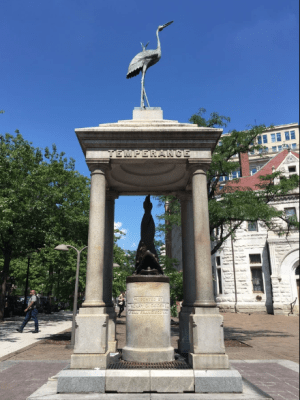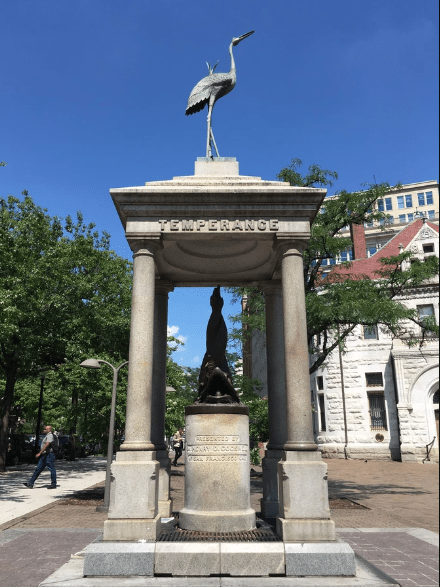The Temperance Fountain
![temperance 4 a statue of a person]()
Welcome to the inaugural edition of Weird Memorials of Washington, a monthly blog post that examines the Capital’s odd and little known monuments, memorials, and landmarks. This month, we’ll discuss the Washington Temperance Fountain, found on our White House & Pennsylvania Avenue tour!
Henry Cogswell’s Temperance Fountain
 Henry Cogswell (1820-1900) had a singular mission: to provide fresh water to the masses. Cogswell grew up in New England in the early 1800s and worked at cotton mills before training as a dentist. During the California Gold Rush, Cogswell and his family moved out west to provide dentistry services and invest in growing gold stocks. There among the hard scrabble miners, prostitutes, and prospectors, Cogswell was exposed to a harsh reality far different from his staid New England upbringing. Chief among the problems, in his mind, was rampant alcoholism. Cogswell’s investments in gold mining paid off, and he used his newfound wealth to promote temperance. Along with other prohibitionist of his day, Cogswell funded the construction of public cool drinking water fountains to lure away those looking to quench their thirst by other means.
Henry Cogswell (1820-1900) had a singular mission: to provide fresh water to the masses. Cogswell grew up in New England in the early 1800s and worked at cotton mills before training as a dentist. During the California Gold Rush, Cogswell and his family moved out west to provide dentistry services and invest in growing gold stocks. There among the hard scrabble miners, prostitutes, and prospectors, Cogswell was exposed to a harsh reality far different from his staid New England upbringing. Chief among the problems, in his mind, was rampant alcoholism. Cogswell’s investments in gold mining paid off, and he used his newfound wealth to promote temperance. Along with other prohibitionist of his day, Cogswell funded the construction of public cool drinking water fountains to lure away those looking to quench their thirst by other means.

Temperance was not a novel concept in the United States in the 19th century. The American Temperance Movement had been steadily gaining steam since the 1820s with the support of organizations like the Anti-Saloon League and Women’s Christian Temperance Union.
Their efforts eventually came to fruition with the passage of the 18th amendment in 1919, legally banning the distribution, sale, and production of alcohol. Prohibition turned out to be a spectacular failure, causing a dramatic rise in organized crime, joblessness, alcohol poisoning, and a whole host of other unintended consequences. The amendment was repealed in 1934, permanently ending the “noble experiment” of prohibition.
Long before prohibition became law, Cogswell set about designing and installing Temperance Fountains, to be placed in areas dominated by bars and saloons. His goal was to build one drinking fountain for every hundred saloons in the United States, and Cogswell successfully erected fourteen temperance fountains across the country, including in Washington, DC, San Francisco, Boston, and New York City.
 Cogswell’s gifts were not well received by the community, and most were subsequently torn down and destroyed. The fountains were largely derided, considered hideous, self-aggrandizing monuments to Cogswell himself. The San Francisco fountain, which featured a life-sized statue of Cogswell holding a glass of water in one hand and a copy of the Temperance Pledge in the other, was ripped down by an angry mob in 1900. His fountain in Rockville, Connecticut was thrown into a lake in 1885. The statue was later recovered, only to be melted down for the war effort in 1941. The Washington, DC fountain is one of the only remaining monuments to Cogswell’s bizarre legacy.
Cogswell’s gifts were not well received by the community, and most were subsequently torn down and destroyed. The fountains were largely derided, considered hideous, self-aggrandizing monuments to Cogswell himself. The San Francisco fountain, which featured a life-sized statue of Cogswell holding a glass of water in one hand and a copy of the Temperance Pledge in the other, was ripped down by an angry mob in 1900. His fountain in Rockville, Connecticut was thrown into a lake in 1885. The statue was later recovered, only to be melted down for the war effort in 1941. The Washington, DC fountain is one of the only remaining monuments to Cogswell’s bizarre legacy.

The Washington Temperance fountain was donated by Cogswell in 1882 and placed on Pennsylvania Avenue. Today, “America’s Main Street” is host to inaugurations, protests, and parades, but historically this famous boulevard bounded one of the worst areas of Washington. Known colloquially as Murder Bay, the neighborhood was a center of crime, gambling, prostitution and alcoholism– the perfect setting for Cogswell’s reforming fountain.
Cogswell paid to have the fountain erected, installed, and connected to the Washington aqueduct water system. The fountain was disconnected by the city shortly after its installation, but still occupies a quiet corner near Pennsylvania Avenue. Designed by the prohibitionist himself, the center of the fountain features two grotesque fish with large open mouths from which water would have flowed. A “common cup” hanging from a chain was provided for public use, and overflow water for horses fell in a trough below. Cogswell even included an ice reservoir, which was never maintained.

The fountain is sheltered by a stone canopy with a large standing heron statue atop it. Four words are etched around the sides: Temperance, Faith, Hope, and Charity. The inscription on the base reads “PRESENTED BY DR. HENRY D. COGSWELL OF SAN FRANCISCO CAL”.
The presence of Cogswell’s Temperance Fountain did little to improve the surrounding neighborhood. In fact, for more than 60 years, it was located directly across from the Apex liquor store. In 1945 the fountain was declared a “monstrosity of art” by Senator Sheridan Downey, who subsequently proposed and pushed through legislation requiring that all gifts to the District be approved by the city Arts & Planning Commission. In 1987 the fountain was moved twice, once across the street and once behind the Grand Army of the Republic Memorial, during the redevelopment of Pennsylvania Avenue.
 Today, the Temperance Fountain is maintained by the Cogswell Society, a group of federal government employees who work at the nearby Federal Trade Commission. Members of the society meet once a month at local bars to discuss “the study of man’s excesses and the lack of temperance in past and present cultures”. The society’s oath, which must be said while standing on one leg in imitation of the heron atop the Temperance Fountain, says “Temperance– I’ll drink to that”.
Today, the Temperance Fountain is maintained by the Cogswell Society, a group of federal government employees who work at the nearby Federal Trade Commission. Members of the society meet once a month at local bars to discuss “the study of man’s excesses and the lack of temperance in past and present cultures”. The society’s oath, which must be said while standing on one leg in imitation of the heron atop the Temperance Fountain, says “Temperance– I’ll drink to that”.
The Temperance Fountain is located at the corner of 7th street and Indiana Avenue, across the street from the National Archives metro station. Visit the fountain for yourself and learn more on our White House & Pennsylvania Avenue tour! Also check out our collaborative video with TripHacks DC about other weird monuments in the District.
#Pennsylvaniaavenue #architecture #WashingtonDC #weirdmemorials #prohibition


 Henry Cogswell (1820-1900) had a singular mission: to provide fresh water to the masses. Cogswell grew up in New England in the early 1800s and worked at cotton mills before training as a dentist. During the California Gold Rush, Cogswell and his family moved out west to provide dentistry services and invest in growing gold stocks. There among the hard scrabble miners, prostitutes, and prospectors, Cogswell was exposed to a harsh reality far different from his staid New England upbringing. Chief among the problems, in his mind, was rampant alcoholism. Cogswell’s investments in gold mining paid off, and he used his newfound wealth to promote temperance. Along with other prohibitionist of his day, Cogswell funded the construction of public cool drinking water fountains to lure away those looking to quench their thirst by other means.
Henry Cogswell (1820-1900) had a singular mission: to provide fresh water to the masses. Cogswell grew up in New England in the early 1800s and worked at cotton mills before training as a dentist. During the California Gold Rush, Cogswell and his family moved out west to provide dentistry services and invest in growing gold stocks. There among the hard scrabble miners, prostitutes, and prospectors, Cogswell was exposed to a harsh reality far different from his staid New England upbringing. Chief among the problems, in his mind, was rampant alcoholism. Cogswell’s investments in gold mining paid off, and he used his newfound wealth to promote temperance. Along with other prohibitionist of his day, Cogswell funded the construction of public cool drinking water fountains to lure away those looking to quench their thirst by other means.
 Cogswell’s gifts were not well received by the community, and most were subsequently torn down and destroyed. The fountains were largely derided, considered hideous, self-aggrandizing monuments to Cogswell himself. The San Francisco fountain, which featured a life-sized statue of Cogswell holding a glass of water in one hand and a copy of the Temperance Pledge in the other, was ripped down by an angry mob in 1900. His fountain in Rockville, Connecticut was thrown into a lake in 1885. The statue was later recovered, only to be melted down for the war effort in 1941. The Washington, DC fountain is one of the only remaining monuments to Cogswell’s bizarre legacy.
Cogswell’s gifts were not well received by the community, and most were subsequently torn down and destroyed. The fountains were largely derided, considered hideous, self-aggrandizing monuments to Cogswell himself. The San Francisco fountain, which featured a life-sized statue of Cogswell holding a glass of water in one hand and a copy of the Temperance Pledge in the other, was ripped down by an angry mob in 1900. His fountain in Rockville, Connecticut was thrown into a lake in 1885. The statue was later recovered, only to be melted down for the war effort in 1941. The Washington, DC fountain is one of the only remaining monuments to Cogswell’s bizarre legacy.

 Today, the Temperance Fountain is maintained by the Cogswell Society, a group of federal government employees who work at the nearby Federal Trade Commission. Members of the society meet once a month at local bars to discuss “the study of man’s excesses and the lack of temperance in past and present cultures”. The society’s oath, which must be said while standing on one leg in imitation of the heron atop the Temperance Fountain, says “Temperance– I’ll drink to that”.
Today, the Temperance Fountain is maintained by the Cogswell Society, a group of federal government employees who work at the nearby Federal Trade Commission. Members of the society meet once a month at local bars to discuss “the study of man’s excesses and the lack of temperance in past and present cultures”. The society’s oath, which must be said while standing on one leg in imitation of the heron atop the Temperance Fountain, says “Temperance– I’ll drink to that”.